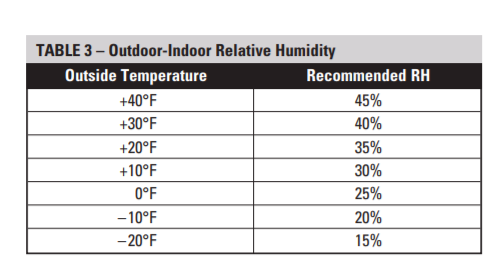Table of Content
To maximize the lifetime, it's important to care for your dehumidifier. Be sure to regularly change the air filters, clean the condensing coils and exhaust grilles, and empty and clean the water bucket. A level of humidity that’s either too high or low can cause health problems as well as damage to your house. The other end of the humidity scale is usually a rarer occurrence, but it can happen. Common causes are excessive use of air conditioning systems and/or dehumidifiers, but it can also come about when we overheat our properties when the mercury drops outside.
Dehumidifiers are designed to turn off when their trays are full of water. This protects your home from flooding and the dehumidifier from water damage. You can ensure that the dehumidifier continues operating by simply allowing it to drain into the main drain.
Maintaining the ideal humidity for your home in winter
"If your home or any part of it has a humidity reading of over 50 percent, consider installing or running a dehumidifier," he says. "An HVAC technician can take a reading or multiple readings throughout your property to determine what level of humidityis currently present." An ideal basement falls within a humidity range of 30–50%. If you’re seeing a humidity level outside that range, you might have a problem and need professional help. If you’re seeing minor oscillations in humidity level that could be considered normal, and are simply looking for ways to reduce humidity healthily, consider a dehumidifier.

You now know what is a good humidity level and how to measure humidity in a room. And now you know what to do, you can help maintain healthy levels of humidity in your home. A standard furnace heats the air and then distributes it throughout the home, but the warming process dries the air and removes valuable humidity. If your home has very low humidity during the winter months, switching from a forced-air heating system to radiant heat will keep the air from drying out.
A Factual Guide on the Ideal Humidity for Your Home in Winter
A whole-home dehumidifier, which is more expensive, but it can dehumidify all the rooms in your house. Since whole-home dehumidifiers are installed in your HVAC system, they need to be installed by a professional. A good humidity level for your basement is around 30%, and there are things you can do to make that a reality. By opening the window on days when it’s cooler outside than inside (assuming it isn’t raining), you can reduce the humidity of the inside air.
The humidity in Florida is always at its highest during the summer and lowest in the winter as mentioned in our home humidity levels chart. Depending on the construction of your home and how well it is insulated, you may not need a humidifier in the winter at all. Heaters can dry out the air pretty fast when it’s cold, so many Florida homeowners may find it helpful to have a portable humidifier on hand. Humidity levels in your home can make a big difference in your level of comfort. Do you have a backyard garden or just like to grow plants indoors?
Normal Humidity Levels for a House
When people talk about relative humidity, they’re talking about the percentage of water vapor in the air at specific temperatures. The parts of your home, such as hallway closets, bathrooms, and basements, have high moisture levels. In the long run, you will see the effects and notice that there will be little to no molds in your home. The figures for the best humidity levels in a room are almost the same as those needed for better sleep.

It is a level that you will also be comfortable in when you are sleeping. The right humidity is an integral factor when it comes to comfort in our bedrooms. One may then ask what is a good humidity level for a bedroom? One that gives you comfort when breathing is the required level of humidity. Luckily, you don’t have to live with high humidity indoors.
What Does “Humidity Level” Mean?
Next, we compared absolute humidity to RH and dew point and learned how to control moisture levels in the house. A digital hygrometer is easy to find and will monitor your home’s moisture level so you can be proactive about creating a relaxing environment. We like this ThermoPro digital hygrometer because it’s easy to read and reports your home’s indoor temperature and humidity level. Plus, the comfort indicator will let you know if you’re approaching a temperature or humidity level outside your desired settings. If you want to measure your home’s humidity you’ll need a hygrometer. A hygrometer is used to measure the humidity level in your house.

Ideally, moisture levels should never go higher than 50% during fall. However, if you live somewhere in Florida, Alabama, or Georgia, humidity levels in the 60–70% range will be common. And in certain areas, 80%+ is what you’ll experience most of the time.
Then make sure you’re keeping moisture levels in check. The soil, nutrients, watering, and sun exposure are, of course, very important, but humidity should also be taken into consideration. If you’re doing everything right, but the leaves are withering or refusing to grow, most likely, humidity is to blame here. Follow our guide on boosting and dropping humidity levels and that should solve the problem.

Too little moisture in the air can have deleterious health effects. Wood furniture can split and crack — from expensive dining room tables and chairs to china cabinets, clothes dressers, and more. If you have wood flooring throughout much of your home, that’s a pretty big investment. Keeping the humidity levels at the right range can save you money and keep the wood in your home in the best shape possible. High humidity can be a prime environment for several problems (and dangers!).
For many reasons, basements tend to be the area of the house that retains the most moisture. Other common issues include static electricity, chipping of paint, and even damage to expensive electronics. Allow bathwater to cool in the tub before draining it to release moisture into the air. Increased energy bills as you turn down the temperature on the thermostat for relief from the humidity. Visible condensation on windows and walls that can produce a feeling of mugginess throughout the home. Humidity levels that are below 40% or above 60% tend to present issues that may negatively affect your home environment.
You’ll get 60 hours of operation time from this unit when it’s set to the lowest mist setting. The Levoit humidifier modifies the humidity level in rooms up to 753 square feet, but if you have a smaller space, check out our list of best portable humidifiers. It is the right product to help control or reduce your home’s indoor humidity levels by pulling moisture out of the indoor air and spitting cooler air back out. In addition, it can also contribute to energy saving with its relation to the use of the HVAC system.
These fans are designed to push humid basement air directly outside through exhaust vents. While all of these issues could pose real threats, mold and mildew are primary concerns for your overall health. For homes in arid regions, a whole-house humidifier will add moisture all year long. Most of today’s new homes have poured concrete basement floors, but many houses built before 1950 still have unfinished dirt floors. The moisture in a dirt-floor basement can be as high as 100 percent, depending on how damp the soil is, and that moisture can filter up into other areas of the home.

No comments:
Post a Comment